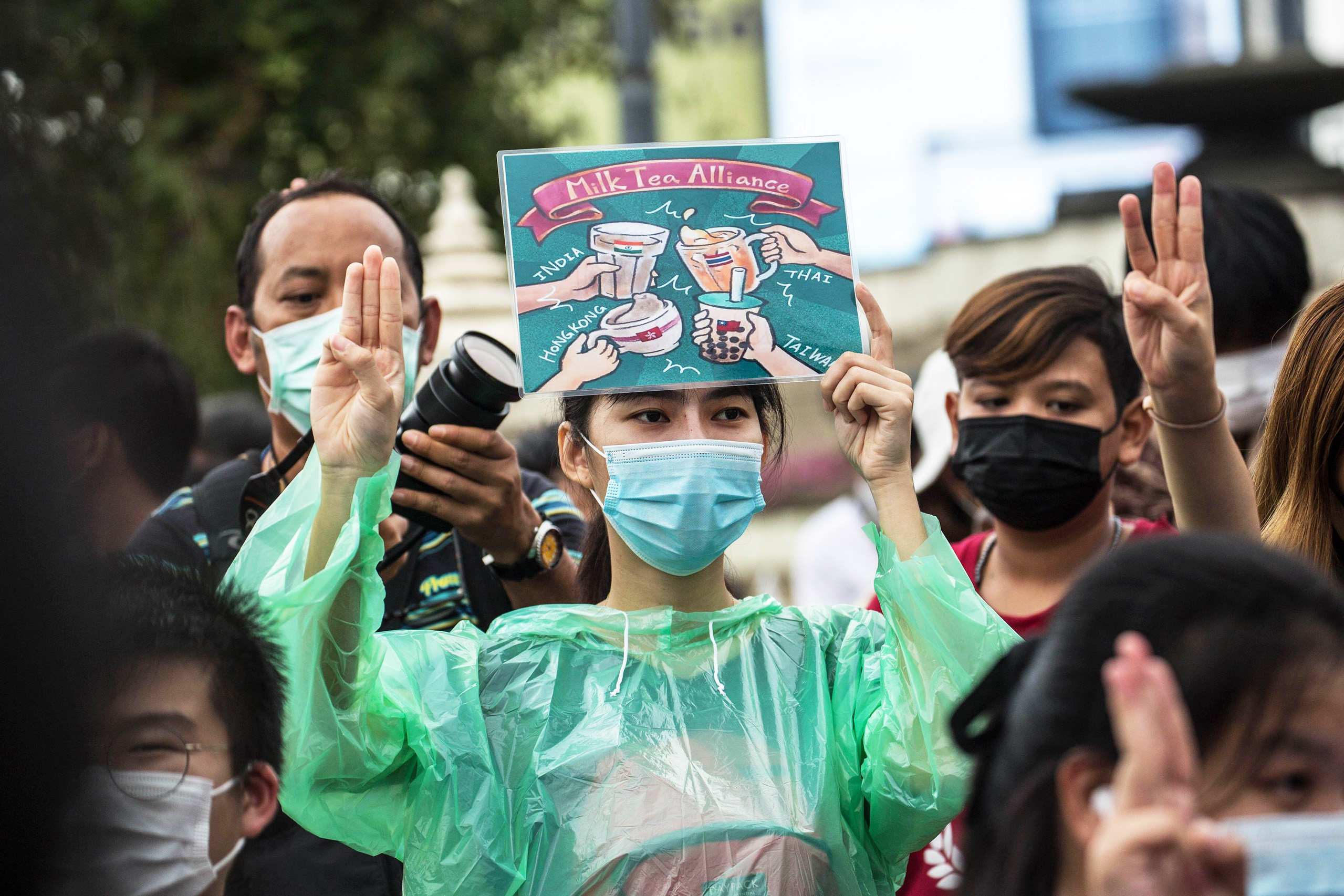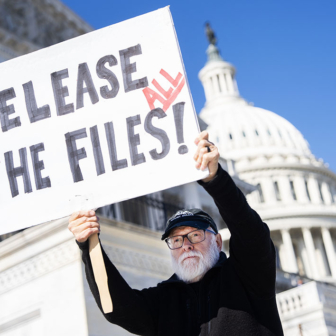The United States is slip-sliding towards authoritarianism under Donald Trump. Elected leaders in Israel, Turkey and Hungary have blurred the line between democracy and dictatorship. North Korean tyrants have kept the show going there for three generations. Militaries rule and misrule in Sudan and beyond. In such times, it is useful to consider not just How Tyrants Fall, to quote the title of Marcel Dirsus’s excellent new book, but also the different forms that resistance can take.
Jeffrey Wasserstrom’s The Milk Tea Alliance looks at the transnational links forged between the youth-led anti-autocracy movements in Hong Kong, Burma, Thailand and other parts of Asia in the early 2010s. Protest leaders in each of these places were dealing with unique political circumstances and challenges. Yet, as Wasserstrom shows, these digital-native activists soon connected online and in some cases in person, learning from and supporting each other’s struggles.
After a Thai actor inadvertently posted a meme identifying Hong Kong as a country, Chinese online nationalists tore into him. Other Thais rose to the counterattack. Chinese nationalists then accused the actor’s girlfriend of supporting Taiwan independence, and on it went, with Hong Kong and Taiwan netizens soon joining in the fray.
Resentment against Chinese interference in regional affairs quickly morphed into a loose, transnational and more broadly anti-authoritarian movement nicknamed the Milk Tea Alliance. The name alludes to the fact that black tea is frequently taken with condensed or sweetened milk in these places — or, in Taiwan’s case, tapioca with bubble tea. The movement’s countless memes include a flag representing a spectrum of milk tea colours.
Members of the Milk Tea Alliance adopted a common symbolic language. Protesters in Thailand raised umbrellas in homage to Hong Kong’s 2014 “Umbrella Movement” and across the region activists embraced the three-fingered salute that accompanies the slogan “If we burn, you burn with us” in The Hunger Games. The salute went mainstream in Thailand in the early 2020s when progressive political candidates began flashing it as well. In an extraordinary gesture of defiance, the Burmese ambassador to the United Nations used it in 2021 during a General Assembly speech supporting pro-democracy protesters and opposing his country’s military junta.
Wasserstrom is the author of Vigil: Hong Kong on the Brink and other works focusing on repression and resistance. He pours a great deal of research into the small cup of this short book, published as a Columbia Global Report. Working with a pseudonymous co-writer from the movement itself, he paints a sympathetic picture of the loosely defined grouping and some of its individual activists. Unfortunately, the length means that Wasserstrom deals only in passing with Taiwan’s 2014 Sunflower Movement, despite Taiwan’s story being central to that of the alliance.
In China itself, with its pervasive internet monitoring, neighbourhood committees, policing grids and an average of one CCTV camera for every two people, it’s impossible to imagine a viable resistance movement. Decades of patriotic education have had their effect as well.
Young Chinese may grumble about burnout and “involution,” and resent the creeping pressure on women to leave the good jobs to men and make babies instead, but the Communist Party is well-entrenched and resistance to its rule (as opposed to individual policies) is rare. Years of this message being drilled into them via education and media, many believe that democracy would not suit their country — that without a strong leadership it would break apart or dissolve into anarchy. Authoritarian culture is so ingrained that when the student-led, pro-democracy movement arose in 1989, the student leaders’ lack of democratic habits and culture led many to adopt the organisational, command and rhetorical styles of the party itself (or at least that of the Red Guard rebels fostered by Mao himself in the Cultural Revolution).
In his introduction to Everyday Democracy: Civil Society, Youth, and the Struggle Against Authoritarian Culture in China, Melbourne University sociologist Anthony Spires notes that most previous studies of civil society organisations within authoritarian regimes have examined the relationship between civil society and the state, asking questions about civil society’s potential as an opposition or even revolutionary force. He has chosen to ask a different question: in China, “where virtually all major social institutions — from schools to workplaces to government — are stitched together with the heavy threads of authoritarian rule,” can civil society associations “serve as large free schools of democracy”?
Between 2005 and 2017, Spires observed civil society organisations in China at first hand. That period encompassed the Xi Jinping’s ascension to power and the intensified crackdown on civil society that began shortly before.
The organisations Spires studied dealt with a range of issues, from women’s rights to autism, environmental protection and care for the elderly in poorer regions. With references to a range of thinkers from the late Qing reformist Liang Qichao to Alexis de Tocqueville, Everyday Democracy provides a nuanced discussion of the culture of volunteering in China. Spires found that — like their 1989 counterparts — many of the university-based or state-led groups replicated the systems of hierarchy and authority that define the Chinese polity, though two grassroots organisations, Together and Bridges, strove to cultivate an alternative and participatory, egalitarian culture.
As Spires notes, the Communist Party’s repeated claims that “democracy,” “freedom” and “equality” are “core socialist values” have had the unintended effect of leading young people to expect, somewhat naively, these values as a kind of birthright. The culture of these grassroots organisations, in which everyone is expected to have their say and be listened to, and in which leadership does not come with any kind of power, matches the promise set out in those values.
Decision-making is not always easy or quick. But Spire’s in-depth interviews with participants, many of whom come from less privileged village or working-class backgrounds, show how Bridges and Together volunteers gained self-confidence, awareness of social issues, an ability to speak to people across various divides and to advocate for better policy, and an appreciation of democratic processes. They are often unable to apply these principles and practices in their working lives, leading some to switch to careers in the law and other fields linked to social justice.
The shape of autocracy — and resistance — varies from place to place. But one thing that unites “tyrants” is their determination to stay in power at whatever cost. As we saw on the streets of Beijing in 1989 and those of Hong Kong, Yangon, Bangkok in the decades since, autocratic regimes are rarely shy about using violence against those who challenge them. And yet, as Marcel Dirsus shows in How Tyrants Fall, there are still ways of bringing them down.
Dirsus draws on a global range of examples to illustrate the extreme lengths to which dictators must go to just to stay in power. “Being a dictator,” he writes, “is like being stuck on a treadmill that one can never get off… If they get distracted for even an instant, their legs may shoot out from under them, and they’ll get hurt.” Hurt as in hunted, tortured or killed. Lucky ones may find somewhere to live in exile, but a secure exile is never a sure thing. To stay in power, he explains, they need “money, weapons and people,” but none of these is simple to acquire or keep.
Dictators must manage the “enemy within,” and that requires sharp intelligence-gathering and military muscle. But the muscle can itself pose a danger to the tyrant’s survival. Saddam Hussein once likened his army to “a pet tiger” but, unable to trust it not to turn on him, set about pulling out the its “eyes, teeth and claws.” Dictators are not opposed to violence, including violence deployed against their own people. To win the people’s support or at least their tolerance, though, they must be able to claim they are providing something their people crave, whether it’s an “end to anarchy” (the Burmese junta’s self-justification), common prosperity (the absolute monarchies of the Gulf) or the raising of the working classes from slaves to masters (communism of various flavours). Whether or not there is truth in the claims is less important than how successful the regime is in conveying them.
How Tyrants Fall is an informative, extensively researched and incongruously entertaining read. Translated from the German by John Murray, it is full of vivid examples taken from around the globe and throughout history. It is laced with wry observations, including the cautionary theme of the penultimate chapter: “be careful what you wish for.” Democracy only followed one in every five dictatorial regimes that fell between 1950 and 2012; most of the time one dictator fell and another rose, often after episodes of violence and chaos.
As Dirsus writes in this thrilling and provocative book’s final chapter, “How to Topple a Tyrant,” if democracy is the goal, a non-violent transition is a better bet. He warns of the dangers of violence yet notes that “as a German who enjoyed freedom from the moment he was born, I am not going to argue that force should never be used to topple tyrants.”
Without claiming it’s easy, he does show how non-violent change can come about. Existing democracies can ban the sale of spyware and military weapons to dictators and offer publicity or safe exile to dissidents. Supporting civil society organisations and unions can help people chip away at a dictator’s power; China’s laws limiting foreign funding and involvement in civil society only prove how threatening such help has been to communist rule.
There’s plenty that people in democracies can do to expose, shame and limit the activities or profits of those unprincipled actors who help dictatorships launder their money or allow them to invest (as Qatar has done in Volkswagen and the Saudis in Google and Zoom).
Outside support for regime change can be a tricky proposition for many reasons, and Dirsus acknowledges that interfering in another country’s affairs, even for noble reasons, presents an ethical minefield. Perhaps transnational activism as modelled by the Milk Tea Alliance, is one answer. With the United States, the world’s biggest democracy, itself teetering on the edge of tyranny, we need as many ideas as possible. •
The Milk Tea Alliance: Inside Asia’s Struggle Against Autocracy and Beijing
By Jeffrey Wasserstrom with contributions by ÓPrad Sirisomboon | Columbia Global Reports | $32.99 | 104 pages
Everyday Democracy: Civil Society, Youth, and the Struggle Against Authoritarian Culture in China
By Anthony J. Spires | Columbia University Press | $57.99 | 312 Pages
How Tyrants Fall: And How Nations Survive
By Marcel Dirsus | John Murray | $24.99 | 304 pages




